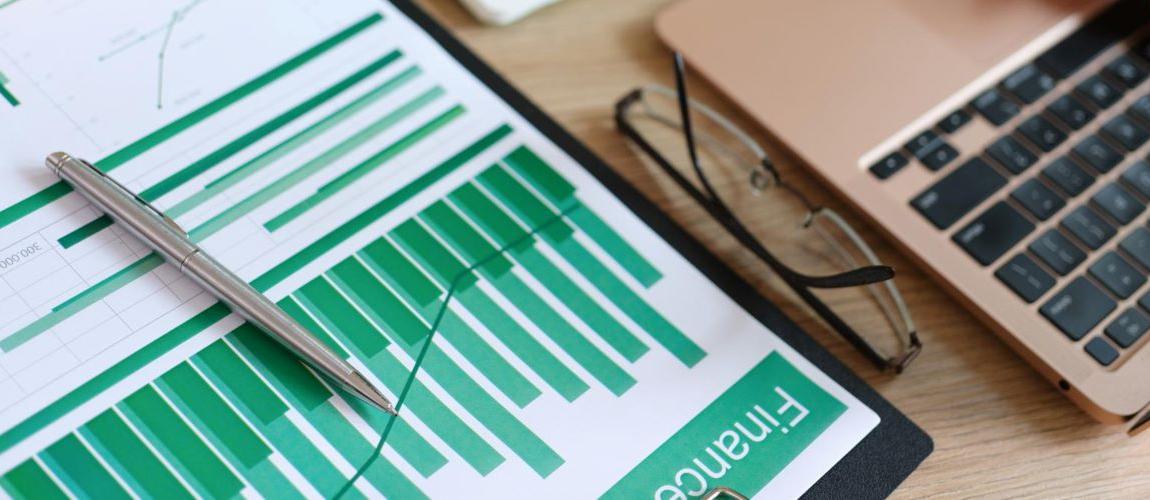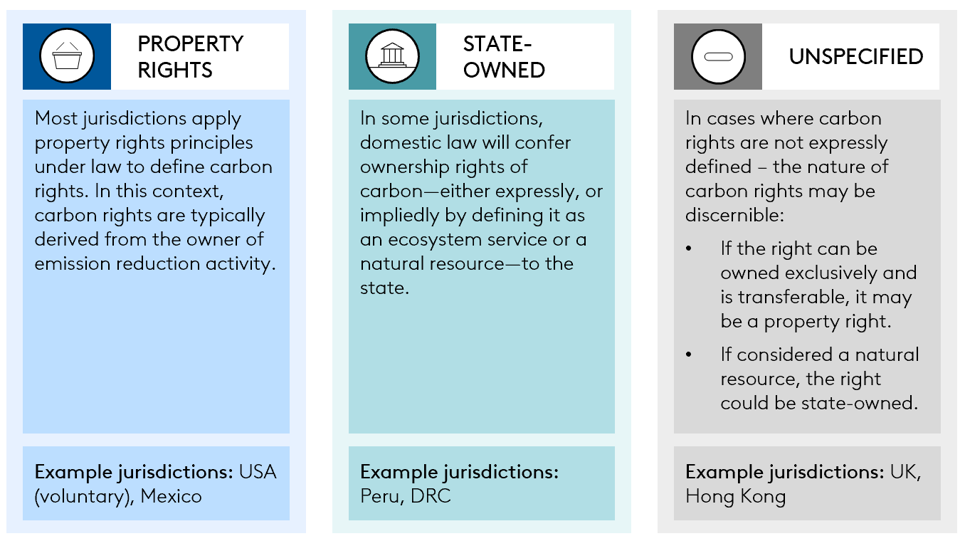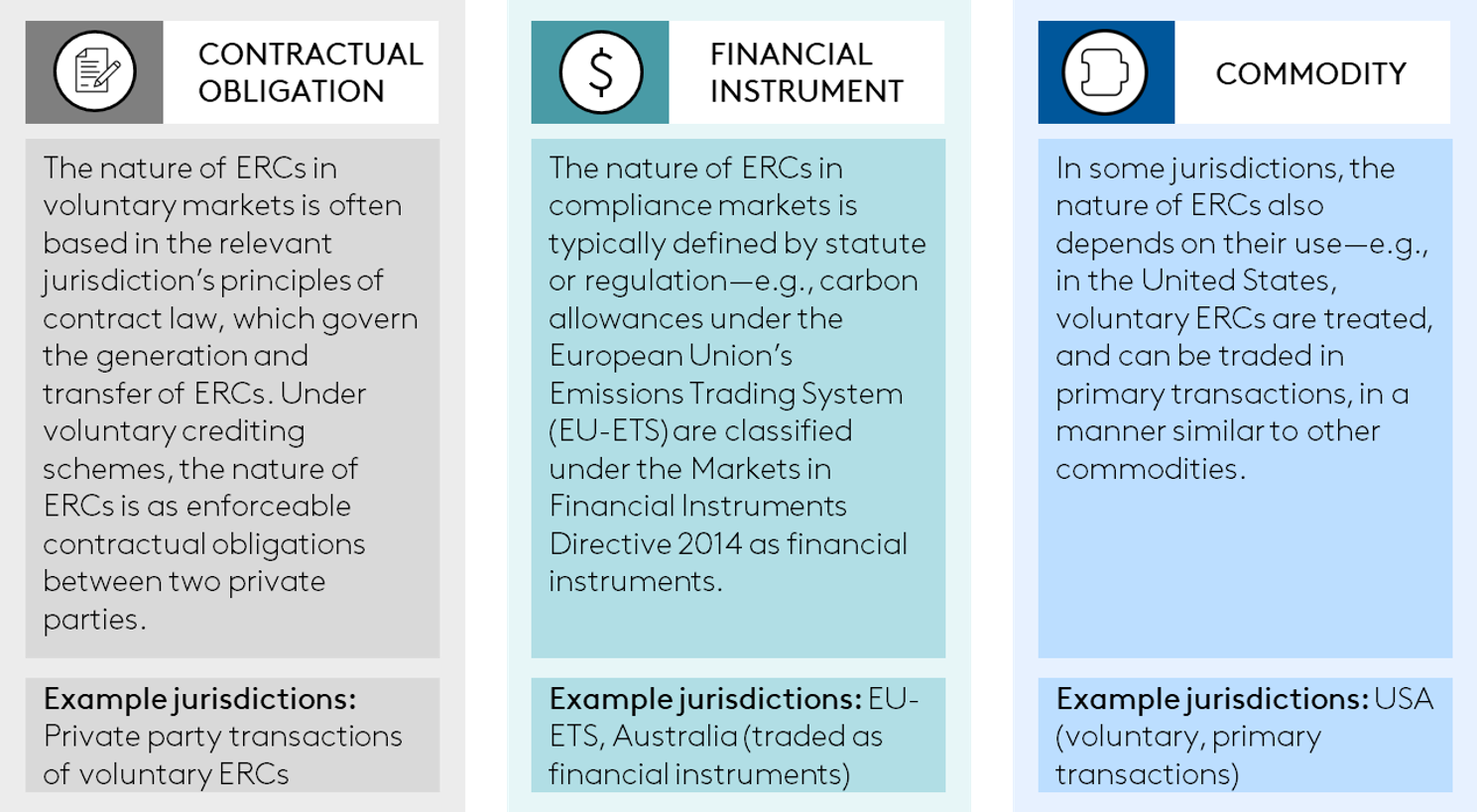Rights to ERCs and Their Benefits

Photo Credit: Image by Freepik
On this page: Clarifying the legal nature of ERCs is crucial to clearly inform how ERCs are regulated. Read more below, or visit Strategic Guidance for Country System Assessments, Guidance for Countries in Assessing ERC Projects, or Mobilizing ERC Finance.
The ability to demonstrate ownership of carbon rights is critical to the ability to generate and transfer ERCs in all carbon market schemes. Governments can support ERC generation by clarifying the legal rights to carbon. Carbon rights are either expressly defined under domestic law or, where not expressly defined, may be discernible by considering other factors related to the activity generating the carbon emission reduction or removal (e.g., treatment of property, natural resource management) (Figure 11). In respect of project-based activities generating carbon emission reductions or removals, the legal rights to such emission reductions or removals are generally attributed—either expressly or impliedly—to the owner or entity in control of the project (i.e., the land or technical solution giving rise to the emission reduction or removal). Alternatively, some countries expressly define carbon rights as belonging to the state under natural resource management laws or regulations. Similarly, in respect of jurisdictional-based activities generating carbon emission reductions or removals, the carbon rights may be attributed to jurisdictional governments either by regulation or contract. Even if the system for defining carbon rights is well-understood based on local law in a given jurisdiction, the processes for demonstrating the holders of such rights are often much more challenging. Particularly for nature-based solutions giving rise to carbon emission reductions or removals, proving that a project proponent holds title to the land from which the emission reductions or removals are generated can be an administratively burdensome and expensive process. Figure 11. Representation of carbon rights and example jurisdictions. Clarifying the legal nature of ERCs is crucial to clearly inform how ERCs are regulated. Under most crediting schemes, both compliance and voluntary, the owner of the underlying carbon rights will be issued the resulting ERCs based on the domestic legal and regulatory regime and the standard and methodology for the applicable crediting scheme. The legal instrument by which carbon rights are then transferred—contractual obligation, financial instrument, or commodity (Figure 12)—will vary across jurisdictions and may also depend on the crediting scheme under which the ERC was issued or the intended use of the ERC. This legal nature will also inform the terms of ERC transactions; underpin the processes by which market participants can protect their rights if default or dispute arises;1affect tax and accounting treatment; treatment in bankruptcy events; treatment of derivative contractual interests; and risk weighting and capital costs of ERCs that are held by supervised financial institutions. As such, it is critical to understand the law governing ERCs, which, depending on the jurisdiction and crediting scheme, may be the law of the jurisdiction in which the emission reduction or removal activity is based, the jurisdiction of the seller or the buyer of the ERC, or the jurisdiction in which the registry housing the ERC is located. Figure 12. Representation of legal nature of ERCs and example jurisdictions. Legal regimes that cover ERC generation, ownership, and use should ensure that the rights of eligible interest holders are appropriately defined and protected. For financiers, these considerations are significant because the ability to establish clear carbon rights through demonstration of title or land tenure may be required as a prerequisite to generating and trading ERCs, as well as to demonstrate unencumbered ownership or other interests in cases of contractual breach or dispute. Key issues include legal ownership of emission reduction and removal activities; transferability of legal title; ownership of land on which emission reduction and removal activities are situated (e.g., public or private); customary land rights held by Indigenous Peoples; whether there are restrictions or controls on foreign ownership of land; and whether expropriation could be triggered. It is helpful for developers and financiers when governments establish clear rules that require project proponents to obtain the consent of eligible interest holders before undertaking emission reduction and removal activities, such as from government parties if the activity is on public land or financial institutions that hold a mortgage over private land. Additionally, government-defined processes to ensure that the rights and knowledge of IPLCs can be instructive, including with respect to FPIC processes.2 This is also essential in seeking to mitigate emission reduction and removal activity-risk by providing relevant stakeholders with the opportunity to exercise self-determination, which may in turn reduce potential conflicts that impact successful activity execution. Legislated requirements for benefit sharing need to balance the need to implement robust benefit sharing mechanisms with maintaining the commerciality of ERC activities and their ability to raise finance. Transparent and equitable benefit sharing is important not only to ensure the legal carbon rights holders receive compensation, but also to help support the long-term viability of the project activity by encouraging local involvement in the project. It has historically been an activity-level consideration and negotiated between the project developers and ERC offtakers. However, some governments have begun to legislate a minimum level of benefit sharing required for ERC activity registration in that jurisdiction (e.g., Kenya’s Climate Change Act3, Tanzania’s Environmental Management Act4). Footnote 1: International Swaps and Derivatives Association, “Legal Implications of Voluntary Carbon Credits”, 2021 ; Ben McQuhae & Co, “The Legal Nature of Carbon Credits”, 2023. Footnote 2: The principle of Free Prior and Informed Consent (FPIC) is enshrined in several international instruments, including United Nations Declaration on the Rights of Indigenous Peoples (UNDRIP), the Convention on Biological Diversity, and the International Labour Organization’s Indigenous and Tribal Peoples Convention, 1989 (No. 169). For example, Article 32(2) of UNDRIP provides that: “States shall consult and cooperate in good faith with the indigenous peoples concerned through their own representative institutions in order to obtain their free and informed consent prior to the approval of any project affecting their lands or territories and other resources, particularly in connection with the development, utilization or exploitation of mineral, water or other resources.” Footnote 3: Kenya Law, Climate Change Act, 2016. Footnote 4: Tanzania, The Environmental Management Act, 2022.

This section is intended to be a living document and will be reviewed at regular intervals. The Guidelines have not been prepared with any specific transaction in mind and are meant to serve only as general guidance. It is therefore critical that the Guidelines be reviewed and adapted for specific transactions. Unless expressly stated otherwise, the findings, interpretations, and conclusions expressed in the Materials in this Site are those of the various authors of the Materials and are not necessarily those of The World Bank Group, its member institutions, or their respective Boards of Executive Directors or member countries. For feedback on the content of this section of the website or suggestions for links or materials that could be included, please contact the PPPLRC at ppp@worldbank.org.
Updated: June 3, 2024
TABLE OF CONTENTS
UNLOCKING GLOBAL EMISSION REDUCTION CREDIT
1. Introduction to Emission Reduction Credits
• The World Bank's Emission Reduction Program
• Classification of Emissions Reduction Credit
• Policy Context of Emissions Reduction Credit
• Current Landscape of ERC Financing
• Financing structures to address key risks
• Debt: Example of Emission Reduction-Linked Bond from Vietnam
• Equity: The London Stock Exchange and Foresight Sustainable Forestry
• Fund: Liveligoods Carbon Fund 3
3. Key Enablers of ERC Finance
• Credit Risk in ERC Finance Transactions
• Political Risk for ERC Activities
• Rights to ERCs and Their Benefits
• Government Engagement and Public Sector Participation
4. Scaling Finance for ERC Generation
• Key Findings to Scale Up Private Sector Capital for ERC Activities
• Expand ERC-Backed Debt Issuance
Related Content
Additional Resources
UN Sustainable Development Goals
The Legal Nature of Carbon Credits
Carbon Integrity (Project Assessment and Final Decision)
Type of ResourceRight Block TitleTABLE OF CONTENTSRight Block DescriptionUNLOCKING GLOBAL EMISSION REDUCTION CREDIT
Guidance for Countries in Assessing ERC Projects
1. Introduction to Emission Reduction Credits
• The World Bank's Emission Reduction Program
•Classification of Emissions Reduction Credit
• Policy Context of Emissions Reduction Credit
2. Objective of the Guidance for Countries in Assessing ERC Projects
• Objective of Project Preparation Guidelines
• Introduction to the Project Assessment Framework
• Process to Conducting Assessments
• S1: Green Economy Priorities
• S3: Article 6 Readiness and Eligibility
4. Conducting the Initial Profiling and Making a Preliminary Decision
• F2: Additional Value Enabled by Project
• C1, C2, and C3: Carbon Integrity and Environmental and Social Risk Management
5. Conducting the Project Assessment and Making the Final Decision
• F1: Project ERC value and F2: Additional Value Enabled by Project
• Q2: Marketing, Sales, and Pricing
• Q3: Project Governance and Structure
• C2: Environmental Risk Management
• C3: Social Risk Management and Benefits
6. Further Guidance for Application
• Country Context-driven Factors
• Considerations for Future Scope
Abbreviations: Guidance for Countries in Assessing ERC Projects